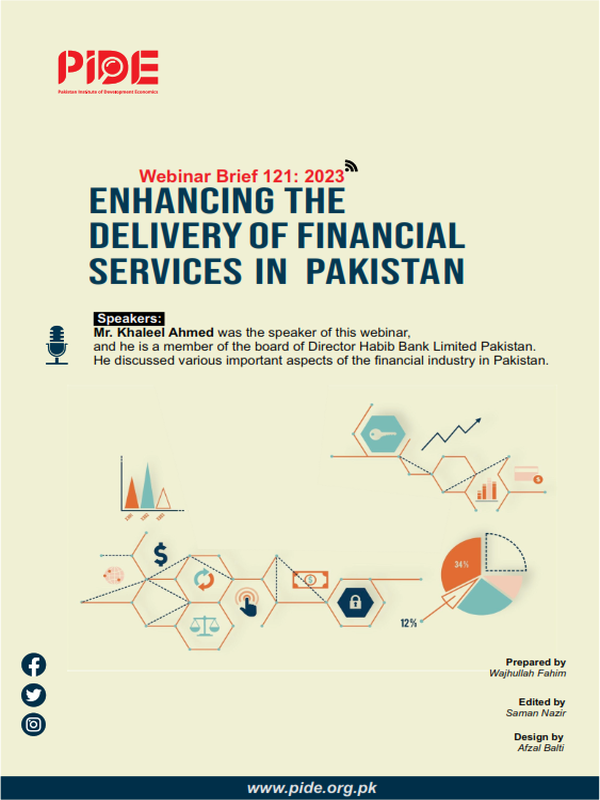Enhancing the Delivery of Financial Services in Pakistan
Pakistan Institute of Development Economics (PIDE) Islamabad hosted a webinar entitled “Enhancing the Delivery of Financial Services in Pakistan.” Dr. Nadeem Ul Haque, Vice Chancellor of PIDE Islamabad, moderated this webinar.
Speaker
Mr. Khaleel Ahmed was the speaker of this webinar, and he is a member of the board of Director Habib Bank Limited Pakistan. He discussed various important aspects of the financial industry in Pakistan.
Discussion:
Importance of Financial system
A robust financial system plays a vital role in economic growth, financial stability, easy access to finance, and capital market formation. A sound financial system gives people the confidence to invest in the economy, which underpins economic growth and development. It increases external relationships by helping payment across borders. Sound financial systems help in the reallocation of resources across different segments of society, improving all welfare levels and long-term financing in the economy. So a stable financial system helps in the efficient allocation of resources, forecasting financial risks, monetary stability, and maintaining the natural rate of unemployment in the economy.
Components of the Financial System
- Laws and Regulation: Like other activities, financial activities also require proper laws, regulations, and regulators. It provides a framework for lending, borrowing, and recovery of money.
- Institutional Structure: A financial system consists of financial institutions, which are Bank and non-Banking, which consists of specialized financial markets. Different financial instruments, such as Assets and Securities, are sold and purchased in financial markets.
- Money & Stability: As money is the primary means of exchange in the economy and regulating the growth of money according to policy produces significant economic impacts, money, and stability are also important elements in the financial system.
- International Financial linkage: As the world becomes globalized, international financial linkage becomes a component of the financial system for promoting international trade and money flows.
Financial System of Pakistan
The financial system of Pakistan consists of both banking and non-banking financial institutions. The banking system consists of 31 banks, out of which 22 banks are private, five are public, and four are foreign banks. The non-banking financial institutions consist of many institutions and companies such as DFS, leasing companies, investment banks, and House finance companies.
Financial Development
Different indicators measure financial development, such as domestic credit to the private sector, the ratio of M2 to GDP, and money supply.
Domestic Loans to the Private Sector
The private sector drives economic growth and development. In Pakistan, the domestic credit to the private sector was 13.7% in the fiscal year 2021, which is very low compared to the world average of domestic credit to the private sector (148%).
M2/GDP
The ratio of M2/GDP in Pakistan has improved in the last few years but is still lower than in our neighboring countries. In FY 2010-11, the ratio was 36.6% which became 43.5% during FY 2021. The M2/GDP ratio in China, India, and Bangladesh are 205%, 81.8%, and 56.6% respectively.
Micro-Finance in Pakistan
In Pakistan, the first micro-finance institution was set by IFC. The micro-finance institutions in Pakistan target focused enterprises and provide basic supplements for entrepreneurs. The micro-finance industry in Pakistan had significant growth in the fiscal year 2022; the annual growth of branches and borrowers increased by 1.1%, while 9.1% annual growth in average loan balance compared to the fiscal year 2021. Besides this growth share of total financing to GDP percentage is lowered than in Bangladesh. In Bangladesh, the total financing to GDP percentage is 5.1%, while in Pakistan only 0.5%. These industries are facing many challenges due to last year’s flood and the current economic conditions of Pakistan.
Financial Inclusion
Financial inclusion helps in economic growth. According to the World Bank, only Afghanistan has a lower rate of financial inclusion for those aged 15+. The State Bank of Pakistan is implementing the “National Financial Inclusion Strategy’ under which there are 96 actions/sub-action and more than 30 different partners. During FY 2021-22, 52 actions/sub-actions have been completed, and at the end of 2023 remaining will be completed.
Gender Mainstreaming Policy:
In December 2020 active account number in Pakistan stood at 52.3%, out of which only 14.5%. To reduce this gap and financial inclusion of women, the State Bank of Pakistan introduced “Banking on Equality: Reducing the Gender Gap in Financial Inclusion“. The following are the main targets of this policy
- 20 million women-owned active accounts by 2023
- 20% of the bank’s workforce to be women by 2021
- 10% Branchless Banking agents to be women by 2024
- 75% bank access points to have trained women champions in place
Housing Finance
Housing finance and mortgage finance is one of the main element in the US and UK financial system. In 2022 the mortgage loans to GDP for Indonesia recorded 378 119%, in India 7861% and in Bangladesh 143%. In Pakistan, housing and mortgage financing laws and regulations need to be reformed for ease in access to titling, and mortgage recovery facilitates, and specialized courts. Such steps help and courage banks to provide housing and mortgage financing.
Tech-funding
The Indian tech development is the result of micro-financing. The ICICI of India promoted Tech in India by providing tech funds, producing two main outcomes. First, it supported small companies in the tech space for their growth, and second, it helped attract private equity and FDI funding. In Pakistan for Fintechs funds from abroad are received, and commercial banks are also backing, but infrastructure development for Fintechs in Pakistan still needs to develop.
Agricultural finance
In Pakistan, banks fund small landholder and mid-segment farmers and livestock financing. For the growth of this sector, more financing is required so that our market can link to the global supply chain and international markets.




